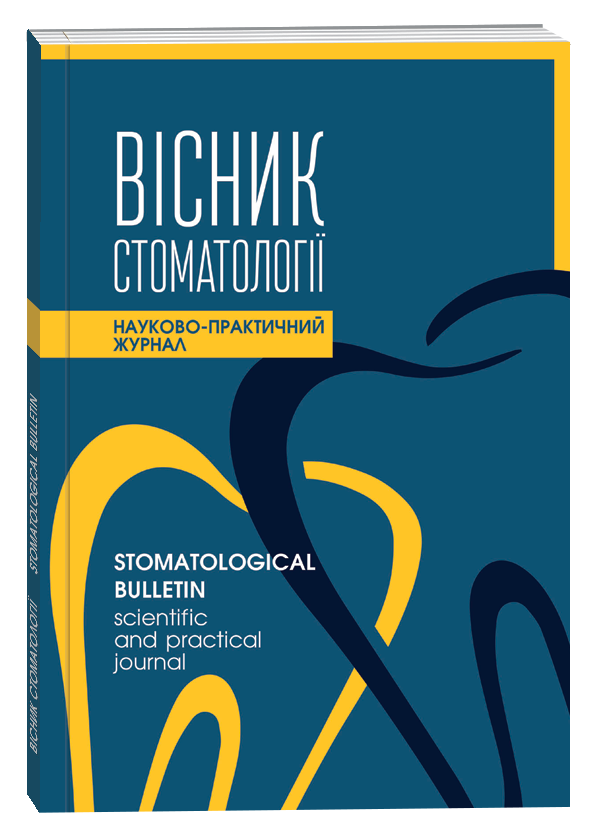FEATURES OF MICROCRYSTALLIZATION OF ORAL FLUID IN CHILDREN WITH DENTAL ANOMALIES
DOI:
https://doi.org/10.35220/2078-8916-2021-40-2.12Keywords:
microcrystallization, oral liquid, children, malocclusionsAbstract
Actuality. Oral fluid is a complex polydisperse non-cellular structure with unstable bonds of its components and in biochemical composition is a lyotropic liquid crystal, which instantly responds to changes in its structural ordering to any external and internal influences. One of the main functions of oral fluid is mineralizing, as it provides secondary mineralization of teeth after their eruption by maintaining homeostasis of the oral cavity, regulation of metabolic processes in tooth enamel by balancing the processes of demineralization and remineralization. Data from the literature indicate the interest of dentists in conducting research to study the microcrystallization of oral fluid. Some researchers found changes in the structural properties of oral fluid during of orthodontic treatment. Special attention should be paid to the study of microcrystallization of oral fluid in children with different types of dental anomalies, considering possible changes in the composition and functional capacity of oral fluid in different pathologies. Purpose of the study. Study of microcrystallization of oral fluid in children with dental anomalies. Material and methods. Material and methods. In order to study the peculiarities of microcrystallization of oral fluid, we studied the peculiarities of crystal formation in 88 children 12 and 15 years of age with malocclusions according to the method of Leus. Results. As a result of the conducted researches it is established that among all examined children the I type of microcrystallization of oral fluid is revealed, on average, only in 32.95±5.01% of children with malocclusions, instead, type II and III crystals occur in 47.73±5.32% and 19.32±4.21% of cases. It was found that among children with cariesresistant enamel type I crystallization, according to average data, found more than half of those examined with malocclusions (53.33±7.44%), type II – in 35.56±7.14% of children, while type III – only in 11.11±4.68% of cases. Instead, among conditionally resistant persons and children with caries susceptible enamel type I crystals were found in 16.28±5.63%, type II – in 32.56±7.14% of the axis and type III in 51.16±7.62%. The results of the obtained data show that among children with anomalies of individual teeth and caries resistant enamel, according to average data, all children had type I microcrystallization. Among conditionally resistant persons and children with caries susceptible enamel and anomalies of individual teeth, type I crystals, according to average data, was detected in 75.00±12.50%, and type II – 3 times less often (25.00±12.50%, p<0.01). In children with anomalies of the dentition and caries resistant enamel type I crystals occurs in 61.90±10.59%, and in conditionally resistant persons and children with caries susceptible enamel – in 36.84±9.01%, p>0.05. At the same time, in children conditionally resistant and caries susceptible enamel and anomalies of the dentition more often detected II (10.54%) and III (3.31 times) types of microcrystallization (p>0.05, p<0.05). Among children with occlusal anomalies, a significantly higher number of people with caries resistant enamel and type I crystals was found in comparison with conditionally resistant persons and children with caries susceptible enamel (6.46 times, p<0.01) and a tendency to increase the number of children with type II and III crystals and conditionally resistant and caries susceptible enamel. Conclusions. Children with malocclusions need to take preventive measures to ensure a constant optimal content of mineral components in the oral fluid in children with malocclusions during active mineralization of permanent teeth, thus creating favorable conditions for "maturation" of enamel after eruption and the formation of resistance to cariogenic factors especially considering the possibility of further orthodontic treatment.
References
Денисов А.Б. Слюнные железы. Слюна [5-е изд. перераб. и доп.] Москва : Издательство РАМН, 2003. 136 с.
Барер Г.М., Денисов А.Б., Михалева И.Н., Ревокатова И.П. Кристаллизация ротовой жидкости при различных условиях. Проблемы нейростоматологии и стоматологии. 1998. № 1. С. 4–6.
Безвушко Е.В. Морфологічна картина ротової рідини у дітей при карієсі зубів з урахуванням екологічних умов проживання. Новини стоматології. 2010. № 2. С. 80–82.
Еловикова Т.М., Григорьев С.С. Слюна как биологическая жидкость и ее роль в здоровье полости рта (Учебное пособие). Екатеринбург : Издательский Дом «ТИРАЖ», 2018. 136 с.
Леус П.А. Клинико-экспериментальное исследование патогенеза, патогенетической консервативной терапии и профилактики кариеса зубов : автореф. дис... д-ра мед. Наук : 14.01.11. Москва, 1977. 30 с.
Нарепеха О.Т., Дубецька-Грабоус І.С. Особливості мікрокристалізації ротової рідини у дітей інтернатних закладів. Вісник вищого державного навчального закладу «Українська медична стоматологічна академія». 2017. Том 17. Вип. 3(59). С. 226–230.
Пачевська А.В., Філімонов Ю.В. Оцінка кристалізації слини в динаміці при ортодонтичному лікуванні дітей. Журнал клінічних та експеритментальних медичних досліджень. 2017. № 5(2). С. 806–812.
Самойленко А.В., Салюк О.Д., Горб-Гаврильченко І.В., Каюкова В.Д. Використання методу мікрокристалізації змішаної слини з діагностичною та прогностичною метою. Медичні перспективи. 2012. Т. XVIII, № 3. С. 1–5.
Скриптина Г.И., Питаева А.Н., Сунцов В.Г. Осадок ротовой жидкости и процессы минерализации эмали зубов у детей. Стоматология детского возраста и профилактика. 2012. № 1. С. 8–13.
Скрипкина Г.И., Екимов Е.В., Митяева Т.С. Минерализующий потенциал ротовй жидкости в детском возрасте. Стоматология детского возраста и профилактика. 2019. № 19(3). С. 47–51.
Смоляр Н.И., Чухрай Н.Л. Особенности минерализирующей функции ротовой жидкости у детей разного возраста. Стоматологический журнал. 2015. Т. XVI. № 2. С. 105–108.
Чуракова Ю.А., Антонова А.А. Микрокристаллография как стандартный метод оценки состояния слюны. Тихоокеанский международный журнал. 2020. № 2. С. 79–81.
Чухрай Н.Л. Структурні особливості ротової рідини у дітей в різний віковий період. Вісник стоматології. 2014. № 2. С. 70–74.
Шпуліна О.О., Алієва І.М. Мікрокристалізація ротової рідини та перспективи її вивчення у профілактичній стоматології. Український морфологічний альманах. 2012. Т. 10, № 3. C. 177–181.
Spinei A., Picos A.M., Romanciuc I., Berar A., Minailescu A. The study of oral liquid microcrystallixation in children with gastro-esophageal reflux disease. Clujul Medical. 2014. Vol. 87. № 4. P. 269–276. DOI: 10.15386/cjmed-387.








